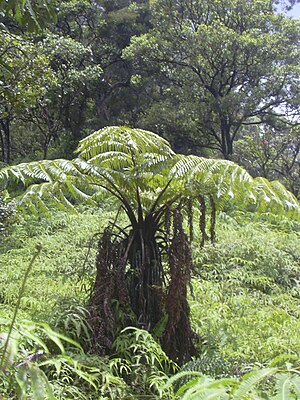Cibotium
| Cibotium | ||||||||||||
|---|---|---|---|---|---|---|---|---|---|---|---|---|

|
||||||||||||
| Systematics | ||||||||||||
|
||||||||||||
| Scientific name of the family | ||||||||||||
| Cibotiaceae | ||||||||||||
| Coral | ||||||||||||
| Scientific name of the genus | ||||||||||||
| Cibotium | ||||||||||||
| Kaulf. |
Cibotium is the only genus of the plant family Cibotiaceae within the order of the tree ferns (Cyatheales). The species are also called casket ferns.
features

The species of the genus Cibotium grow terrestrially . They have a massive rhizome that is creeping, ascending, or upright, and grows to 6 meters high. The rhizome has a solenostele or dictyostele. They have soft yellow hair on the top end. The whole rhizome is covered with the permanent leaf bases of the fallen leaves.
The leaves are usually 2 to 4 meters long. The petioles are hairy at the base. They have three wavy vascular bundles that together form an omega. The leaf blades are double pinnate or double pinnate, also multiple. The secondary and tertiary leaf axes are furrowed on the surface. The nerves end freely; they are simple or forked or feathery. You stomata have three accompanying cells.
The sori are on the leaf margin (marginal) at the ends of the nerves. The indusia are bilobed, each with an outer, non-green indusium and an inner, tongue-shaped indusium. The paraphyses (sterile threads) are thread-shaped. The spores are spherical-tetrahedral, with distinct edges and a distinct equatorial brim.
The antheridia walls are five-cell.
The basic chromosome number is x = 68.
Systematics and distribution
The genus Cibotium Kaulf. was set up by Georg Friedrich Kaulfuss . The family Cibotiaceae Korall was in 2006 by Petra Korall in A classification for extant ferns. In: Taxon , Volume 55, Issue 3, page 712.
The genus Cibotium occurs on both sides of the Pacific: from East to Southeast Asia , Malesia, Hawaii and from southern Mexico to Central America. There are two types in China.
The genus Cibotium is monophyletic . The Cibotiaceae family is related to the Dicksoniaceae family .
The genus Cibotium contains about eleven species. Among them are (selection):
- Chinese box fern, also called vegetable lamb, ( Cibotium barometz (L.) Sm. , Cibotium assamicum Hook. , Cibotium djambianum Hasskarl , Cibotium glaucescens Kunze ): It occurs in northeastern India , Myanmar , Thailand , Vietnam , in the western part of the Malay Peninsula , from Java to Sumatra , on the Ryūkyū Islands , in the central part of the island of Taiwan , in central Tibet and in the Chinese provinces of Chongqing , Fujian , Guangdong , Guangxi , Guizhou , Hainan , Hunan , Jiangxi , Sichuan , Yunnan and Zhejiang .
- Cibotium cumingii Kunze : It occurs in Taiwan and the Philippines .
- Hawaiian box fern ( Cibotium glaucum (Sm.) Hook. & Arn. ): It occurs in Hawaii .
- Cibotium regale Verschaff. & Lem. : It occurs from Mexico via Guatemala , Honduras , Belize to El Salvador .
- Mexican tree fern ( Cibotium schiedei Schltdl. & Cham. ): It occurs in Mexico and perhaps in Guatemala.
One fossil rhizome was described in 1933 as Cibotium iwatense Ogura from the Late Cretaceous Period from the Japanese prefecture of Iwate.
supporting documents
- Alan R. Smith, Kathleen M. Pryer, Eric Schuettpelz, Petra Korall, Harald Schneider, Paul G. Wolf: A classification for extant ferns. In: Taxon. Volume 55, No. 3, 2006, ISSN 0040-0262 , pp. 705-731, abstract, PDF file .
Individual evidence
- ↑ Cibotiaceae at Tropicos.org. Missouri Botanical Garden, St. Louis, accessed February 23, 2019.
- ↑ a b c Zhang Xianchun, Harufumi Nishida: Cibotiaceae , pp. 132-133 - online with the same text as the printed work , In: Wu Zheng-yi, Peter H. Raven, Deyuan Hong (ed.): Flora of China. Volume 2-3: Lycopodiaceae through Polypodiaceae. Science Press and Missouri Botanical Garden Press, Beijing and St. Louis, 2013, ISBN 978-1-935641-11-7 .
- ^ A b Vascular Plants of the Americas : Cibotiaceae at Tropicos.org. In: 83 . Missouri Botanical Garden, St. Louis
- ↑ Walter Erhardt, Erich Götz, Nils Bödeker, Siegmund Seybold: The great zander. Encyclopedia of Plant Names. Volume 2. Types and varieties. Eugen Ulmer, Stuttgart (Hohenheim) 2008, ISBN 978-3-8001-5406-7 .
